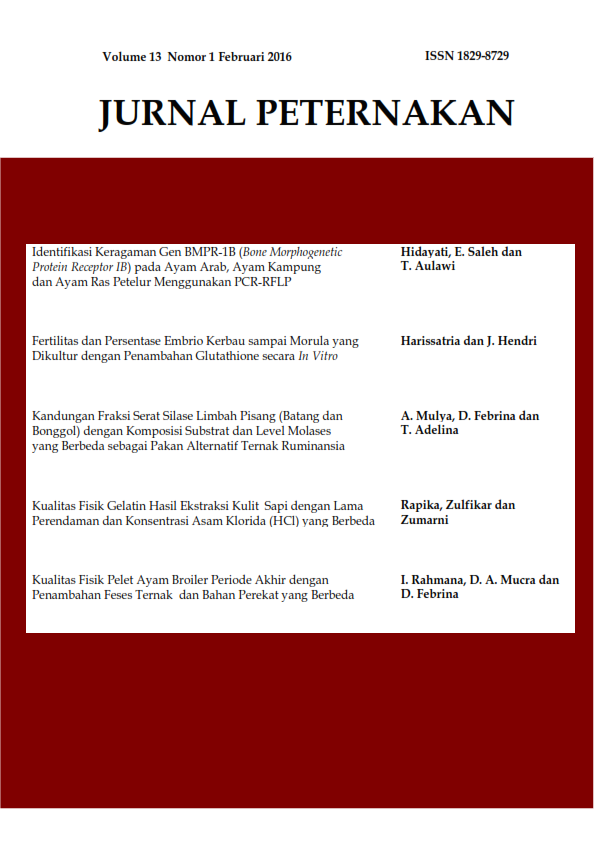KANDUNGAN FRAKSI SERAT SILASE LIMBAH PISANG (BATANG DAN BONGGOL) DENGAN KOMPOSISI SUBSTRAT DAN LEVEL MOLASES YANG BERBEDA SEBAGAI PAKAN ALTERNATIF TERNAK RUMINANSIA
DOI:
https://doi.org/10.24014/jupet.v13i1.2385Keywords:
by product, ensilage, ADF, NDF, ligninAbstract
Harvesting bananas will produce stems and stump that can be used as an alternative feed. One processing techniques to
maintain the nutritional value is silage. This study aims to determine the content of the fiber fraction ie. Neutral Detergent Fiber (NDF), Acid Detergent Fiber (ADF), lignin, cellulose and hemicellulose from bananas waste silage with the composition of the substrate and the different levels of molasses. Research using a Completely Randomized Design factorial pattern with two replications. Factor A : the composition of the substrate, A1. stumps 100% : stems 0%; A2. 50% stems : 50% stumps; A3. 0% stumps : 100% stems. Factor B : the addition of molasses 0%; 2.5% and 5%. Data were analyzed using a completely randomized factorial design, the difference between treatments tested Duncan's Multiple Range Test (DMRT). The results showed banana waste silage with the composition of the substrate and molasses with different levels have moderate physical qualities and fiber fractions are NDF 57.86-89.63%; ADF 34.44-46.20%; lignin 11.75-17.19%; cellulose 15.10-32.34%; hemicellulose 11.66-55.18%. Silage that contains 100% of banana stem with the addition of 5% molasses is the best result.
Downloads
Published
Issue
Section
License
The Authors submitting a manuscript do so on the understanding that if accepted for publication, copyright of the article shall be assigned to Jurnal Peternakan and published by Fakultas Pertanian dan Peternakan Universitas Islam Negeri Sultan Syarif Kasim Riau as publisher of the journal.
Authors who publish with this journal agree to the following terms:
Authors automatically transfer the copyright to the journal and grant the journal right of first publication with the work simultaneously licensed under a Creative Commons (CC BY) that allows others to share the work with an acknowledgement of the work's authorship and initial publication in this journal.
Authors are able to enter into separate permission for non-exclusive distribution of the journal's published version of the work (e.g., post it to an institutional repository or publish it in a book), with an acknowledgement of its initial publication in this journal.
Authors are permitted and encouraged to post their work online (e.g., in institutional repositories or on their website) prior to and during the submission process, as it can lead to productive exchanges, as well as earlier and greater citation of published work (See The Effect of Open Access).

